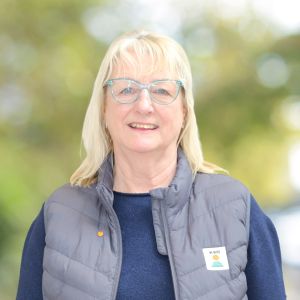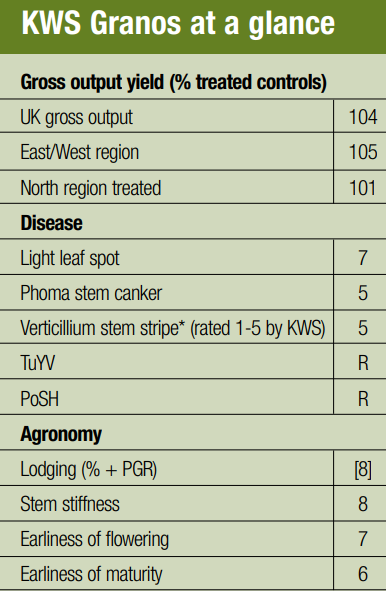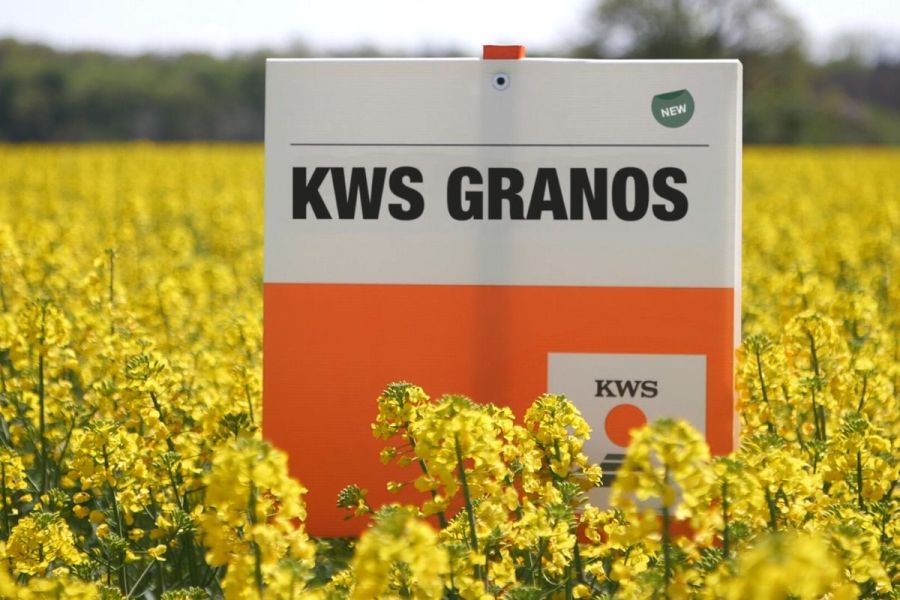Oilseed rape selection is no longer just about gross output and high oil content, loaded agronomic traits are now just as important. Cue, the first commercial variety from KWS’ new hybrid breeding programme, KWS Granos. CPM gets the scoop.
“It’s got the traits that are appealing to farmers these days.”
By Melanie Jenkins
For the past few years, some may have noticed an absence of new oilseed rape varieties coming from KWS’s breeding programme, however this is changing. Back in 2020, the firm made the decision to stop producing new conventional varieties and instead focus solely on hybrids.

Beckii Gibbs feels that stem health is a strong feature in Granos.
Since then, several varieties going through the company’s breeding programme have stood out, but it’s KWS Granos that is the first one to be made commercially available. According to Beckii Gibbs of United Oilseeds, it’s been a while since KWS has had a variety of Granos’ calibre. “It’s a big shame that the variety didn’t make it onto the AHDB Recommended List as it’s a good one.”
Granos is going to sit as an East/West variety and be one for the non clubroot areas of northern England rather than Scotland, with a gross output of 105% in the former region and an oil content of 45.5%, says Beckii. “It’s got pod shatter and Turnip Yellows Virus (TuYV) resistance, a score of 7 for light leaf spot and 5 for phoma stem canker.”
According to Julie Goult of KWS, it was Granos’ phoma score combined with its North gross output of 101%, which meant it missed out on gaining a spot on the RL.
Paul Gosling of AHDB feels that OSR breeders have done a great job over recent years. “They’ve pushed the disease resistance of varieties ever higher, bringing in new traits, like TUYV and pod shatter resistance, alongside increasing yield.
“As a result, the winter OSR RL is very competitive, and varieties must have all bases covered to be recommended. Granos was one of those ‘nearly’ varieties. In the end the committee felt its phoma resistance wasn’t good enough for an East/West recommendation and its yield was too low for the North.

Julie Goult points out that Granos sits in the medium flowering window with a score of 7, has a maturity of 6 and also has the pod shatter (PoSh) gene.
“KWS did present some data to the RL committee indicating Granos may have good tolerance to verticillium, but the committee couldn’t take it into account because it’s not something we currently report in the RL, though hopefully we will be doing so from harvest 2023,” adds Paul.
Nick Mecrow of United Oilseeds feels that Granos is a modern hybrid, ticking several boxes for desirable traits. “More and more, farmers are concentrating on trying to reduce the risks of growing OSR and one of the biggest risks is losing the crop right at the point of harvest, which is why having pod shatter resistance is so important.”
Stem health is another aspect of Granos that Beckii feels is strong. “KWS has also demonstrated Granos has good tolerance to verticillium stem stripe,” she adds. “It’s got the traits that are appealing to farmers these days. We’ve been banging on for years that varieties should have these traits and now KWS has brought one such variety to the market.”
Working in the eastern counties, Nick also feels that one of the most attractive qualities in a variety is strong tolerance to verticillium stem stripe. “Growing varieties which demonstrate this is further helping to reduce risk.”
But because Granos is a new variety, Nick hasn’t yet seen it come to harvest. “I have two growers with Granos in the ground and what I’ve seen of the variety so far appears to be good. It’s hard to say definitively at this point, so we’ll have to wait until harvest to know exactly how Granos performs.”
Julie points out that Granos sits in the medium flowering window with a score of 7, has a maturity of 6 and also has the pod shatter (PoSh) gene.
The variety comes from KWS’ German breeding programme, which is a fairly new direction for the firm. “It’s very encouraging to be getting hybrids from both France and Germany into official UK trials,” says Julie. “Four or five years ago we weren’t entering any material from Germany and now we’ve seen Granos make its way to being a candidate variety for the RL and we have more material in National List trials. It’ll be an interesting space over the next few years.”
According to KWS, its programme has always looked to produce varieties with good standing and disease resistance, specifically light leaf spot, and for some years has pot tested for verticillium with ADAS. “We, unfortunately, had a variety that crashed to verticillium eight years ago, so now we test everything and throw a lot of material out,” explains Julie. “It’s very difficult to breed resistance to the disease, but by testing varieties we know they won’t succumb as badly as Quartz did.”
It’s also becoming an expectation that new varieties should have pod shatter and TuYV resistances, she says. “And we can tick those boxes with the new material we have coming forward.”

According to Pei-Chen Wu, a lot of focus has been put into the disease resistance of hybrid varieties in the firm’s breeding programme.
According to Pei-Chen Wu, KWS’ OSR breeder, a lot of focus has been put into the disease resistance of hybrid varieties in the firm’s breeding programme. “It’s now easier to stack multiple resistances in one variety, and Granos is one of these.”
And with growers still severely feeling the loss of neonicotinoids, autumn and spring vigour have become a more important focus for breeding programmes, explains Julie. “We’ve noticed farmers are drilling OSR earlier and earlier. And although growers have the option to go in late with hybrids, if there’s moisture then they want to get the crop in before the end of August and the peak period for cabbage stem flea beetle migration.”
In further efforts to tackle the pervasive pest, KWS is specifically looking to identify new varieties with resistance or tolerance to it, according to Pei-Chen. “Our focus to tackle CSFB hasn’t just been about how vigorous a variety is but is also looking at other potential traits and genetic factors. We know that the pest is one of the biggest concerns for growers and although there’s no resistance labelling yet, we’re finding variation in the material we, and our partners, are doing research into. There are some interesting results to look out for in the future.”
So where does Granos fit into the market? The firm was naturally disappointed that the variety wasn’t elevated to the RL but feels this by no means diminishes its traits, says Julie. “LG Aurelia is the best-selling variety in the UK and Granos more or less matches it, with as high a gross output in the East/West, and it equals its standing ability with slightly earlier flowering.”
Julie believes the variety has a lot to offer even though it didn’t secure a place on the RL. “Granos is one point adrift in terms of phoma stem canker scoring but in our own verticillium tests it has done better.”
And as with other crops, having a mix of varieties from different genetic sources could be a wise decision, she suggests. “Anyone already growing Aurelia should find that Granos fits well in their rotation.”
The talk in the industry is that the coming summer may see growers struggling to get seed stocks for some varieties in good time for early drilling. “We saw a lot of early drilling last year, with growers wanting seed ready on farm so they could drill when conditions were right, but there will be Granos seed available,” says Beckii.
Julie feels that after a few years of muted progress for KWS’ OSR varieties, the firm has now got things right with some exciting new varieties in the pipeline.
KWS Granos at a glance

Sources: AHDB Recommended List trials and *KWS, [] – limited data
This article was taken from the latest issue of CPM. Read the article in full here.
For more articles like this, subscribe here.
Sign up for Crop Production Magazine’s FREE e-newsletter here.




